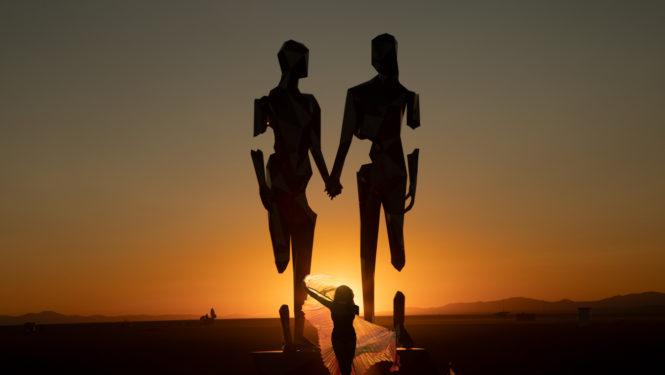The 2019 AfterBurn report has landed. The AfterBurn is our annual look back at the past year, with reports from various departments on their successes, challenges and changes, both on and off playa. You can read the whole report here.
The 2019 calendar year heralded some major metamorphoses for Black Rock City and the worldwide culture it birthed. Burning Man Project CEO Marian Goodell started the year by sounding the clarion call for change, and highlighting efforts to address the erosion of key Principles such as Decommodification, Radical Self-reliance and Participation in our desert home.
These efforts included calls for community help to stop the creep of Instagrammer culture, and the promotion of products on playa: from the big and splashy, to the smaller festival-wear business brigade. These communications worked hand in hand with the third year of the cross-departmental initiative Project Citizenship, which focused on Decommodification, Radical Inclusion and exclusivity, and Greening your Burn.
We supported these Cultural Course Correcting efforts by making changes to ticketing; tightening the Outside Services Program; and issuing warnings to camps commodifying the BRC experience or being exclusive to participants not camping with them.
Theme camps were also the focus of one of the biggest projects this year, Cultural Direction Setting. Guided by a vision group of community members and Burning Man Project staff, the project turned extensive community consultation into a Vision for Residential Black Rock City. The year was bookended with the launch of the project’s second phase, which is working on solutions for implementing the Cultural Vision.
This year, Black Rock City rose to one of its greatest challenges and illustrated the collective power of our community when the Bureau of Land Management released its draft Environmental Impact Statement (EIS) for our new 10-year event permit. An outpouring of community support and substantive comments helped ensure we did not see dumpsters, private security and concrete barriers in Black Rock City.
Burning Man Project also rose to the global challenge we all face around climate change. We took the first steps towards transforming our environmental impact by releasing the Environmental Sustainability Roadmap.
Meanwhile, we marked the one year passing of Burning Man Founder Larry Harvey by calling on our global community to Leave a Positive Trace on the solstice, and by co-organizing a Permaculture Action Day at Hoover Elementary School in West Oakland.
On playa, it was a year of ch-ch-changes too. The art theme Metamorphoses drew a record number of placed artworks (415), and a record number of theme camps (1,545) were placed.
With Larry no longer designing the Man Base, the Art Department collaborated with community artists to build the 2019 Man Pavilion, which was designed by Yelena Filipchuk and Serge Beaulieu, and supported 26 aerial performances. Community artists also designed civic plazas on the 9 o’clock, 12 o’clock and 3 o’clock sides of the Man, where participants could connect.
Kerry Smith Cassidy created E Pluribus Unum: Out of One, Many with its circular seating and LED flowers; Benjamin Rowe created Small Community Shelters, which had delightful moments of canopy and shade; and the Man Base Crew created Man Pavilion Cafes, a circle of European-inspired cafes. Out in deep playa, Geordie Van Der Bosch and his crew also built the Japanese Torii-gate inspired Temple of Direction.
Despite tougher test standards and significant post-event weather setbacks, the Black Rock City site passed the post-event BLM inspection. We also had the greenest MOOP Map to date — testament to the incredible work of the entire Black Rock City community and to the Playa Restoration Team that stepped up to ensure we considered our impact and left no trace.
Beyond the playa, Burners Without Borders focused on community resilience building by distributing around $40,000 microgrants to projects around the world; Civic Arts helped place more Burning Man art in urban spaces than ever before; and Global Art Grants funded a total of $100,000 to 17 projects and programs across 11 countries.
Fly Ranch also continued to develop as an incubator space for community, collaboration and innovation, and Black Rock City drew interest from urban planners and city leaders about its own ability to incubate participatory citizens and co-created cities. Another delegation of US Mayors visited BRC this year; our Speakers Bureau received dozens of requests to speak about building Radical Cities; and 2018 Economics Nobel Prize Winner Paul Romer visited BRC for the first time and declared: “It’s just like every other city, except in this other way, it’s like no city ever.”
Read the full 2019 AfterBurn report here.
Top photo: “Broken But Together” by Michael Benisty (Photo by Eleanor Preger)


Does it report on how many people caught the Pabst Blue Ribbon Virus?
Report comment
Comments are closed.